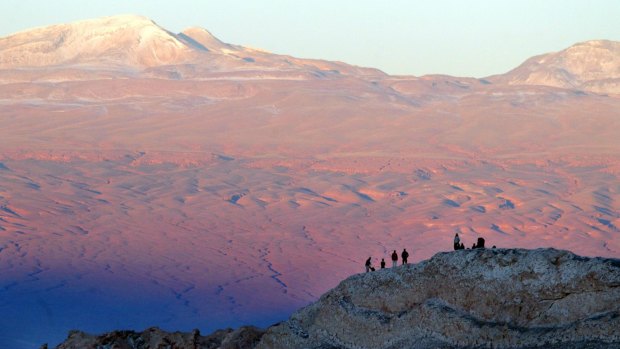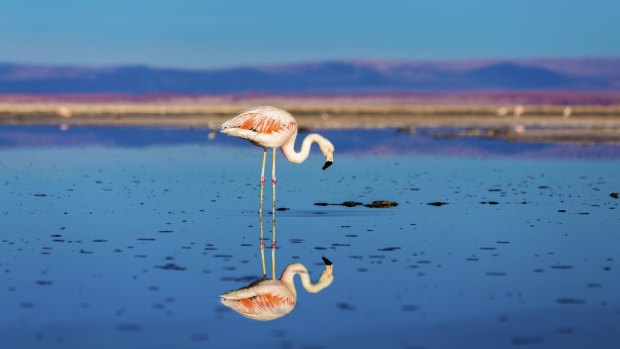This was published 9 years ago
Atacama, Chile: The real Never Never Land, where no-one grows old
By Craig Tansley
"Ride like a man, not like the English …" The Criollo horse beneath me has broken into an uneven trot, its hooves tap-dance along the hard dusty streets surrounding the desert town, San Pedro de Atacama. Out of instinct, I rise and fall with the jerky motion, bending then straightening my legs from the stirrups, hoisting myself up and down to avoid an awkward - and rather painful - collision between my bony posterior and a hard leather saddle.
"No, ride like a Chilean," guide Yasu Beltrami demonstrates beside me, his bottom never rises for a moment from the saddle. "Move your hips only, like you're making love to a woman," he says and yet it's as if he's not moving at all. I fight the urge to rise and remain in the saddle. I try shifting my hips back and forward in pace with my tough little horse, but this isn't lovemaking, it's first-timer's sex: awkward, clumsy, regrettable. I'm not dancing the same dance as my steed: each bump vibrates through my body: a blunt, sharp pain that works its way up my spine and into my skull.
Defiant, I decide to ignore Beltrami's advice and rise and fall in the saddle like a proud Englishman might, determined nothing will taint this joy ride. The jarring in my tailbone subsides slowly; then Blond Boy breaks into a steady canter and I push myself firmly into the saddle and lean back, taking in every bit of my surreal surroundings.

Tourists rest above a hill in Valle de la Luna (Moon Valley) in the nature reserve of Los Flamencos in the Atacama Desert. Credit: Reuters
I'm cantering hard across an ancient, sandy desert – the world's most arid, the Atacama – into a place called Death Valley. It's just Beltrami and me now – there's no-one else around for miles. Sand dunes rise and fall to the horizon - endless mounds of orange-brown sand surrounded on all sides by gnarled clifftops hundreds of metres above us, triangular columns and distant volcanoes pitted against a cloudless blue sky that stretches all the way to Bolivia.
Travel is all too often a futile exercise in measuring reality over expectation; long queues to the Louvre in July aren't how you pictured summer in Paris, aggressive touts hard-selling replicas of the Pyramids isn't how you dreamed of Egypt, but here, in this moment, not a grain of sand is out of place.
As soon as we find a suitable stretch of flat, untracked soft sand Beltrami tells me we'll progress to a gallop - I've never gone beyond a canter. "It's okay, it's soft, you fall, it doesn't matter," Beltrami says. "Hold the reins tight, stand in the saddle and pull hard on his head when you want to stop."

Wild flamingo in the Atacama Desert. Credit: iStock
And then we find our spot and Beltrami kicks his stead twice into motion and my horse follows suit and we're racing each other across the Chilean desert and nothing else but right now matters. My heart feels like it might leap right out of my chest; all I hear is the sound of it beating blood frantically to my brain mixed up with the frenetic drum beat that is my horse's hooves forging a path through this lonely valley. I'm lost entirely in this moment, I can't really understand why I feel this way - I can't even begin to fathom this high - and I know if I analyse this moment later I won't ever be able to recreate it entirely in my mind. So I go with it now for all it's worth, because nothing might ever feel this good again, and people won't understand when I try to tell them. For in this moment – galloping across a desert like a madman in a blockbuster – reality has blurred itself with fantasy and I am the traveller I always wanted to be.
But then, that's the real appeal of the Atacama; for this surely is a giant movie set made for travellers to disappear deep into, far from the scourge of mass tourism and package tourists in large shiny coaches. In the Atacama nothing looks like anything from the world you came here from.
While the Atacama can get busy in peak season, there's a hell of a lot of desert travellers can evaporate into. Even the region's main tourist town (which, incidentally, is one of Chile's top tourist hot-spots), San Pedro, still seems to function as the same ole turn-of-the-20th century frontier town it once was, blissfully free of the usual tourist eyesores like Starbucks and sprawling, homogenous hotel chains.
"Around here we call San Pedro Never Never Land," Beltrami says as we follow a shepherd on our horses as he manoeuvres a herd of goats and llamas through San Pedro's dry, dusty streets. "Here, no-one grows old." San Pedro has been inhabited for more than 10,000 years, but these days - aside from long-term locals and seasonal tourism workers – the town's a beacon for every type of misfit in South America and beyond. Characters in rags, wizard hats and hippie clobber stroll the town's narrow dusty streets in between centuries-old buildings of adobe brick and stone, stopping to rest under trees, away from the harsh sun.
Everything is calico-coloured – like the whole region got painted when everyone was sleeping - even the stunted, gnarled deciduous trees that scratch at me as I ride across town look like they're sprinkled with calico-coloured dust.
The Atacama is one of Chile's most popular tourist attractions. Located in the country's far north, it's the driest place on Earth – some areas in the desert have had no rainfall in more than 400 years - not a single drop. Its dry, orange sands have been compared by scientists with those you'll find on Mars - should you make it there. Because of its otherworldly appearance, the Atacama is used by Hollywood to depict Mars on film - if you don't. And yet there's far more here than endless columns of shifting sand; the Atacama hosts one of the planet's most diverse desert landscapes – from meandering salt flats to green canyons, hot springs and gushing geysers to lush lakes and smoking volcanoes that stick up six kilometres and more.
I arrive at my hotel late at night, walking past its adobe-brick exterior to a darkened open-air restaurant and bar. Under the bright stars I can see across the hotel's vegetable gardens and fields of alfafa and sunflowers to the snow-capped 6000 metre-high Licancabur volcano. My room also looks out on the volcano (there are eight visible from the hotel), framed by ancient algarrobo trees on what was an old cattle corral where drovers who brought cattle across the Andes from Argentina stopped to rest their herds. There's no moon – just the tiniest of crescents – but the light is so bright from the stars I'm forced, reluctantly, to draw my curtains to sleep (because of its low humidity, high altitude and complete lack of pollution the Atacama is the best place on Earth for star-gazing).
There are many activities on offer around the Atacama: my hotel offers more than 20 alone as excursion options. Travellers can choose between four-wheel-drive adventures, horse-riding, mountain-biking, hikes, star-gazing tours or the very adventurous can opt to climb to 6000 metres to sit atop Chile's most active volcano, Lascar. One morning I wake long before dawn to travel by 4WD to the Tatio Geysers, the largest geyser field in the southern hemisphere, located at an altitude of 4300 metres where huge steam columns erupt 10 metres into the air. We travel past flamingos in salt plains, on a road that winds across a lunar landscape devoid of trees, before climbing up high into sharp triangular volcanic peaks lit up by golden rays of the sunrise. Later that day I ride a bike across a salt flat to float on the clear waters of a salt lagoon, on another afternoon I hike beside tiny waterfalls and cascades in a winding river bed within a hidden valley, past 400-year-old cactuses, jumping across rocks, teetering on edges, walking past ancient paintings and petroglyphs thousands of years old.
But when the heat mercifully drains out of the day, I ride my bike from my hotel along narrow dirt streets lined with mud-brick fences that corral llamas, sheep and goats, with just the stars to guide me into San Pedro. There's not a single street light outside San Pedro, but the beaming planets and the auroras of tiny star grains and fiery shooting stars light my way.
I drink a Rica Rica Sour (a local variation on Chile's Pisco Sour, made with Rica Rica desert herbs) at a cosy tavern with an open fireplace where logs burn in winter. Then I walk to to the town square where there's always some kind of procession to join in on – along cobbled streets crowded with locals dressed in pagan costumes dancing to swift beating drums as travellers dine alfresco looking on, gorging on their surroundings. But in tiny stores and centuries-old churches beside the square, locals dance for no one but themselves (and me), the tourists far too enamoured with the frivolity outside under all those bulging, blinking stars.
FIVE MORE THINGS TO DO IN THE ATACAMA
HIKE A VOLCANO
If you'd rather a less intimidating volcano descent than Lascar try a seven-hour hike to the top of Toco whose summit is at 5600 metres. You'll need some time to acclimatise before attempting this ascent which takes in stunning views of the Bolivian Antiplano.
BIRD-WATCHING
The salt flats of the Atacama are home to some of South America's most exotic birdlife, like the Andean and Chilean flamingos. You'll also find rare species of ground doves, thrushes and other species in open wetlands and canyons.
RELAX IN HOT SPRINGS
It doesn't have to be all about adventure in the Atacama: the Puritama Hot Springs are eight natural pools of hot water hidden at the bottom of a steep gorge surrounded by vegetation perfect for long soaks at a temperature of 33 degrees.
VISIT A MUSEUM
Understand the history of San Pedro at the town's archaeological museum and visit the nearby ancient Quitor Fortress for a look back into the history of the region and its inhabitants.
SPOT THE STARS
Take a guided star-gazing tour of the planet's clearest night skies, using the area's gigantic private telescopes. Because of its dry climate and high altitude you'll see more stars here than at any other destination on Earth. Little wonder the Chilean Government launched the largest astronomical project in existence here.
TRIP NOTES
MORE INFORMATION
GETTING THERE
LAN operates seven one-stop flights weekly from Sydney to Santiago, Chile, with onward connections to the Atacama, and three direct flights weekly from Sydney to Santiago in codeshare with Qantas. See lan.com or call 1800 558 129.
STAYING THERE
Tierra Atacama offer a variety of rooms with transfers, all meals, an open bar and excursions included, see tierraatacama.com
The writer travelled as a guest of Tierra Hotels and LAN
Sign up for the Traveller Deals newsletter
Get exclusive travel deals delivered straight to your inbox. Sign up now.